Alongside its alternative scene, many visitors to Berlin want to know the best place to see the Berlin Wall or, more precisely, where to see what still remains of it. For 28 years a concrete wall over 100km long divided Berlin, and the entire country. Now it’s one of the main go-to sights in Germany’s capital.
On my first trip to Berlin as a 16-year-old history student, I didn’t want to just see the Wall – I tried to absorb every ounce of information I was feed to know why; to find the reason and to understand the consequences. I’d look at people my parent’s age and wonder about their individual stories during the Wall years of 1961 – 1989 and I’d look at people my age and wonder how the ideologies they’ve grown up with shape their outlook today in a unified city.
Years on, and a dozen visits to Berlin later, I am still finding pockets of the city that are windows to the past, of which I share with you here on where to both see remaining parts of the Berlin Wall, alongside exhibitions, memorials and museums to gain a deeper perspective.
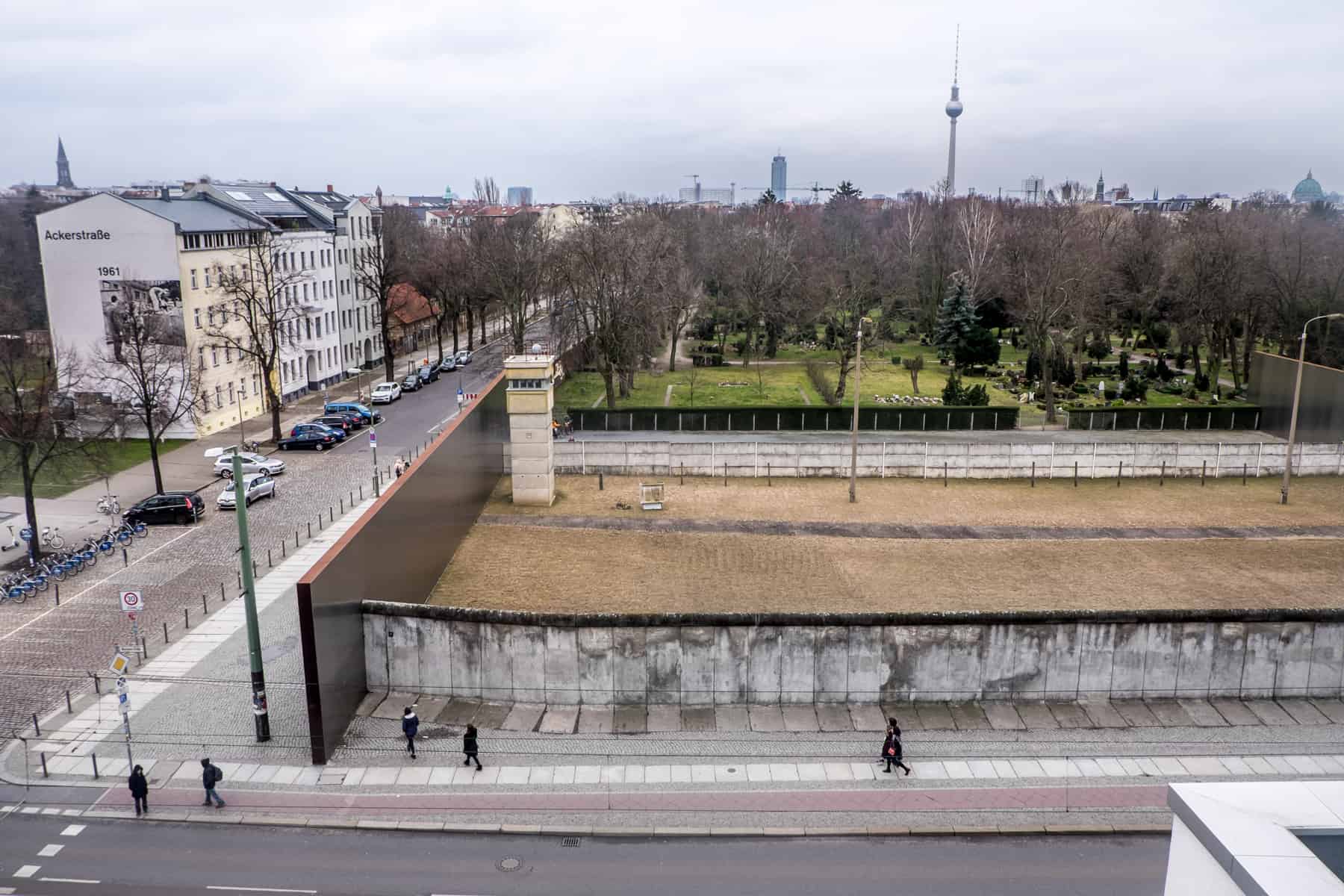
The Best Place to See the Berlin Wall and What to Learn From It
History of the Berlin Wall
2019 marked 30 years since the fall of the Berlin Wall, a shocking symbol of the division of Berlin, Germany and the Cold War, which finally came down on 9th November 1989.
Visiting Berlin today, it’s hard to think that this thriving, fun and booming European hotspot was once partitioned into East and West (alongside West Berlin’s encirclement by its own Wall), a physical division that began in 1961.
READ MORE: What is Berlin Like? Understanding the City Since the Fall of the Wall
A Brief Timeline of Berlin Wall History
Germany and Berlin were divided long before 1961, with a division that began at the end of World War II. After Germany’s surrender on 8th May 1945, the Allies divided the country into four military occupation zones at the Potsdam Conference. The United States occupied the southeast, France the southwest and Britain the northwest forming the Federal Republic of Germany (FRG) and the Soviet Union occupied the northeast, forming the socialist German Democratic Republic (GDR) bordering Poland and Czechoslovakia.
Berlin, in its entirety, was located in the occupied Soviet Zone of Germany. However, because of its importance as the capital of Germany as well as having been the former seat of the Nazi government, Berlin was also split into a quadripartite.
Over 2.5 million people fled communist East Germany for democratic West Germany between 1946 and 1961. On 26th May 1952, fearing an economic collapse, East Germany closed its border with the West via a five-kilometre wide exclusion zone to curb the mass exodus.
More dissatisfied East Germans continued to leave, and since the only way through was via West Berlin, the Soviet government completely sealed the border. On 13th August 1961, rapid construction of the Berlin Wall began.
The Berlin fell after Peaceful Revolutions in the country calling for German Reunification and an end to oppression and then Soviet leader, Mikhail Gorbachev’s abandonment of Eastern bloc policies. This loosening of power and the end of the Socialist Unity Party of Germany (SED) culminated in a bureaucratic blunder by East German party official, Günter Schabowski who accidentally stated in a press conference on 9th November 1989 that the border at the Berlin Wall was open, effective immediately.
The Reunification of Germany began in October 1990. A year later, the destruction of the Berlin Wall began in November 1991.
The Route of the Berlin Wall Today
As you stroll through Berlin today, you will notice two rows of cobbled stones marking where the Wall once stood – a concrete barrier which cut off West Berlin from East Berlin and East Germany. While the city is reunited, its past is not forgotten. The trail of stones means that this piece of history is firmly in your consciousness as you wander.
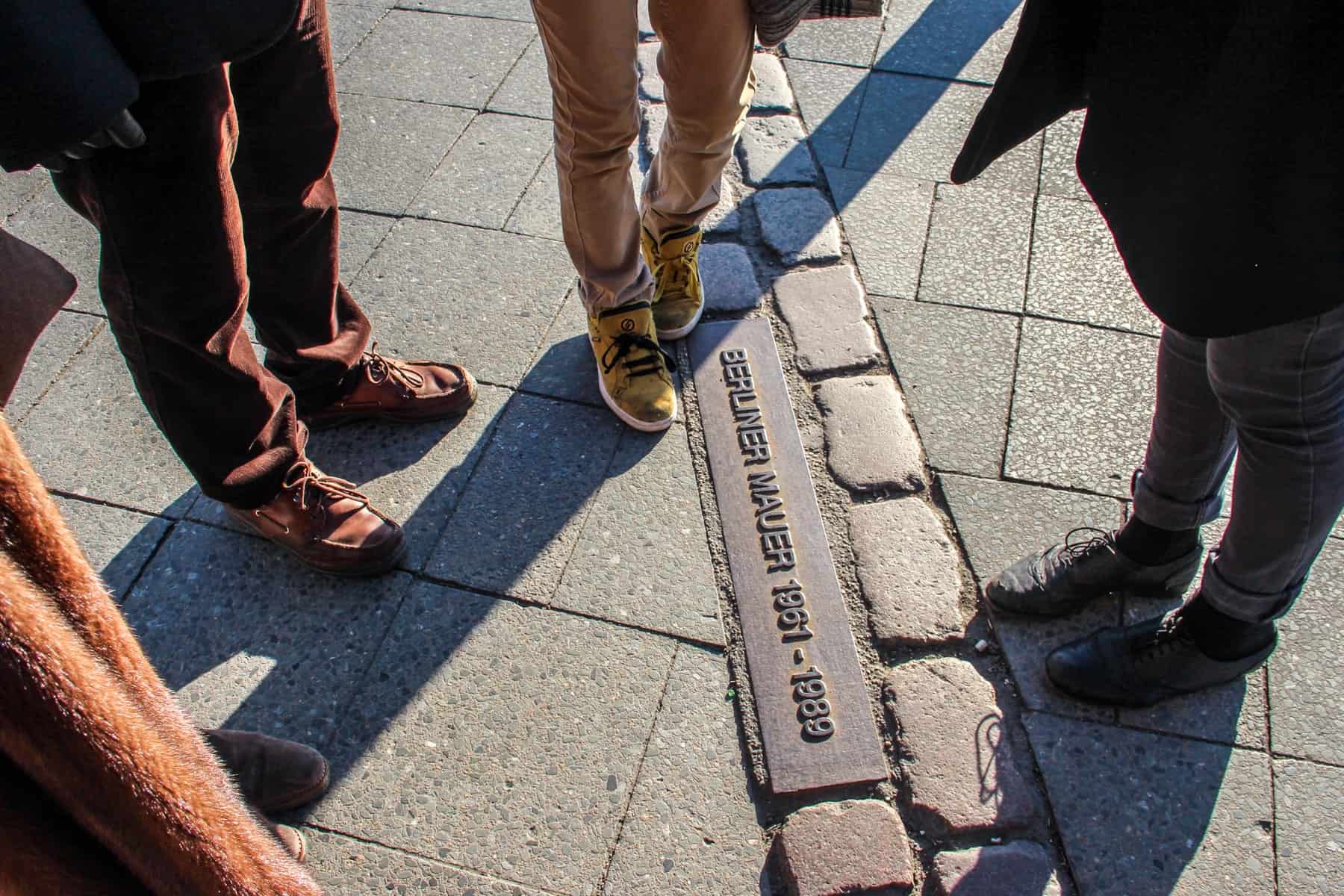
At times it is hard to define which side is East and which is West due to the rapid and continuous construction (marked by a sea of cranes, scaffolding and overland pipes). I found myself continually whipping out my map and trying to work it out. But there are still some parts of the city that feel shrouded in the dark past, still trying to catch up with the unified present, still trying to modernise and fit in, still bearing the scars of Soviet influence while its western sibling glistens as new. Or is it just that those districts are still living in and holding on to the past? After all, not everyone wanted the Wall to come down.
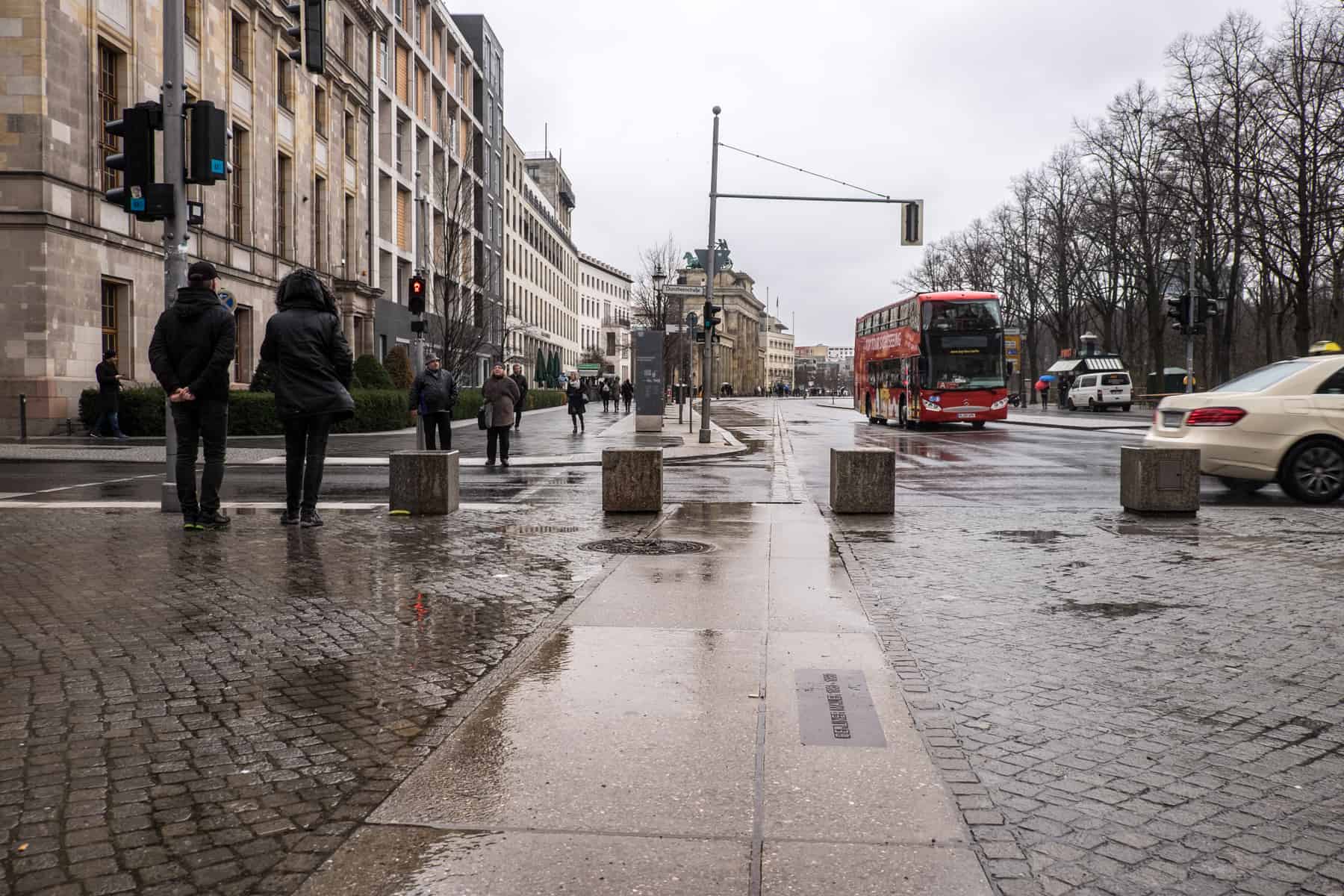
It was those moments that made me feel confused about what I felt about Berlin. What should it be? Will it ever be a city as one? Will there always be an East and West divide because the scars run too deep? Has gritty become ‘cool’ because that’s the only way to justify and accept post-war devastation?
Where is the Best Place to See the Berlin Wall – Preserved Sites and Memorials
Today, only a small fraction of the Berlin Wall remains, and those preserved parts of the Wall serve as memorials. Without it there in front of you as a stark realisation, you wouldn’t be able to imagine how imposing a structure it once was. Or how imprisoned it must have made people feel, the desperation it caused among people separated from loved ones, the distinct lack of choice and freedom.
So before you strike a ridiculous pose on it or scribble your name on it, think about what it is, what it means, and what it symbolises. Ultimately, take the time to understand these lessons from a dark period of modern history.
The East Side Gallery – Where to See the Berlin Wall Murals
Possibly the most famous of Berlin Wall sites, The East Side Gallery is the best-preserved and longest part of the Wall at over 1 kilometre long. It is adorned with colourful murals painted by international artists, which have been there since 1990 – a year after the boarders of East and West started to open.
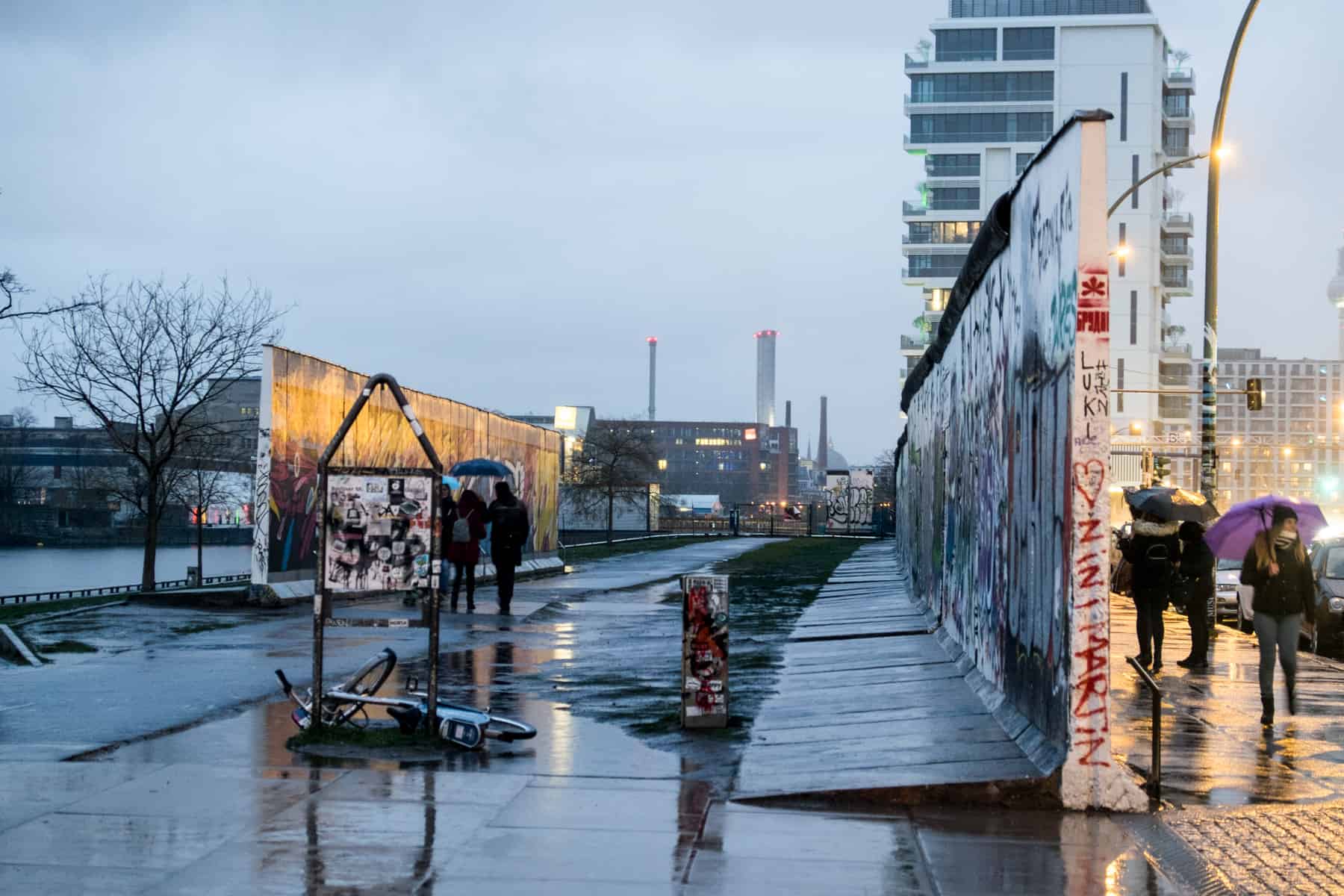
It’s an array of spectacular colour and creative vision along the banks of the River Spree, but much of this open-air gallery carries political messages and symbols of peace. It’s humbling and stands as a warning for history not to repeat itself, alongside highlighting current world issues such as Climate Change.
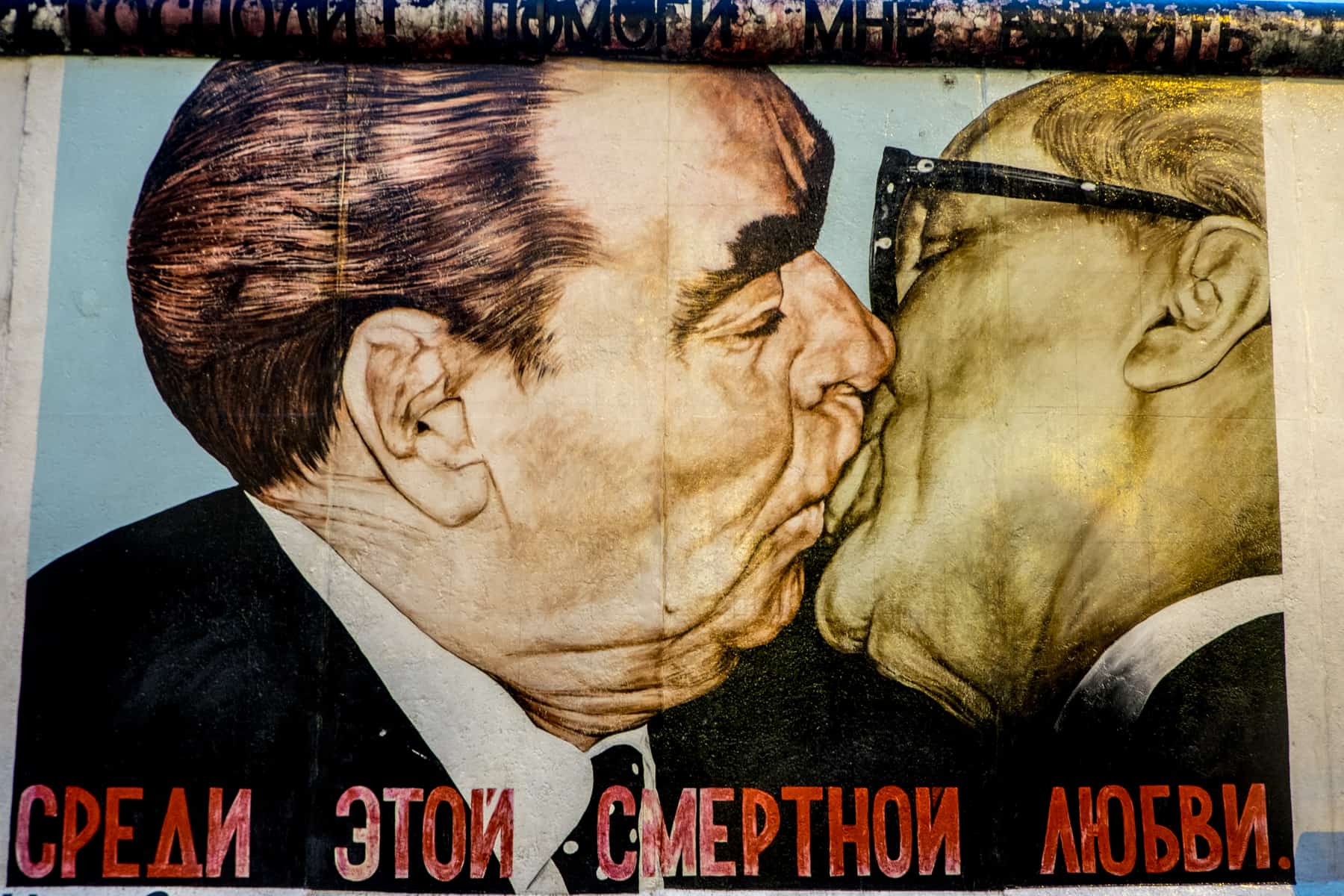
‘The Kiss’ is the most famous artwork on the Berlin Wall East Side Gallery
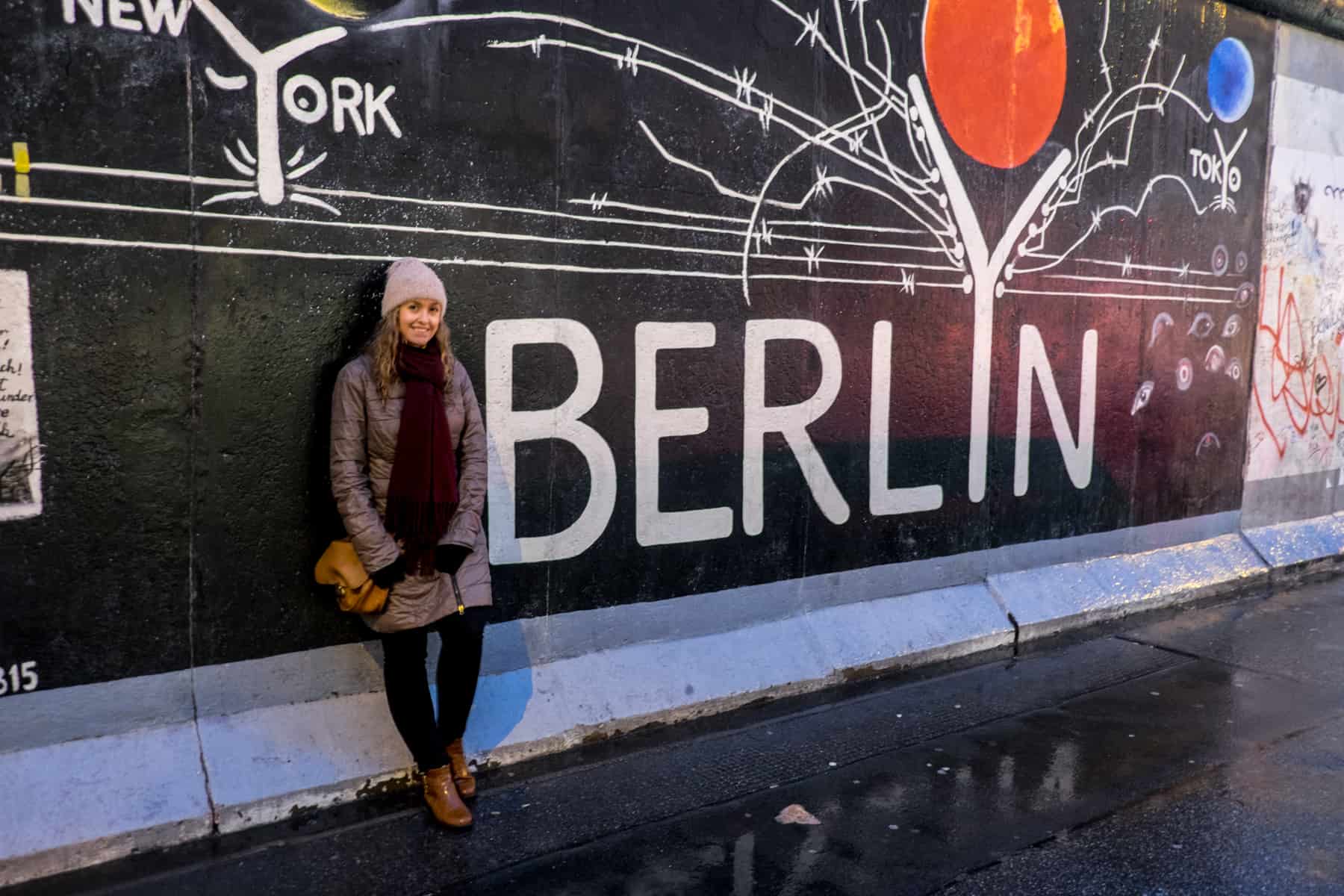
Eastside Gallery ‘Berlyn’ Artwork
It’s an area that also brings people together in the multicultural unison Berlin is known. Behind sections of the Wall, you will find a few bars including one on a boat, one with a handcrafted beach and the funky Jamaican themed bar, Yaam.
How to get to the East Side Gallery: S-Bahn Station Ostbahnhof (and a short walk)
The Berlin Wall Foundation has a dedicated website complete with images and information on guided tours at the East Side Gallery.
Bernauer Strasse – The Street of The Berlin Wall Memorial
The entire stretch of the historical Bernauer Straße (street) is a Berlin Wall Memorial, where you will find yourself walking within the former border strip, also known as the ‘Death Strip’.
The open-air gallery highlights how the border facilities were constructed and controlled, and the urban destruction it caused. On one side you will see preserved sections of the Inner Wall how this particular section of Wall was connected to and built into houses and other main buildings – the Wall erected directly in front of the buildings situated on the East Berlin side of the street.
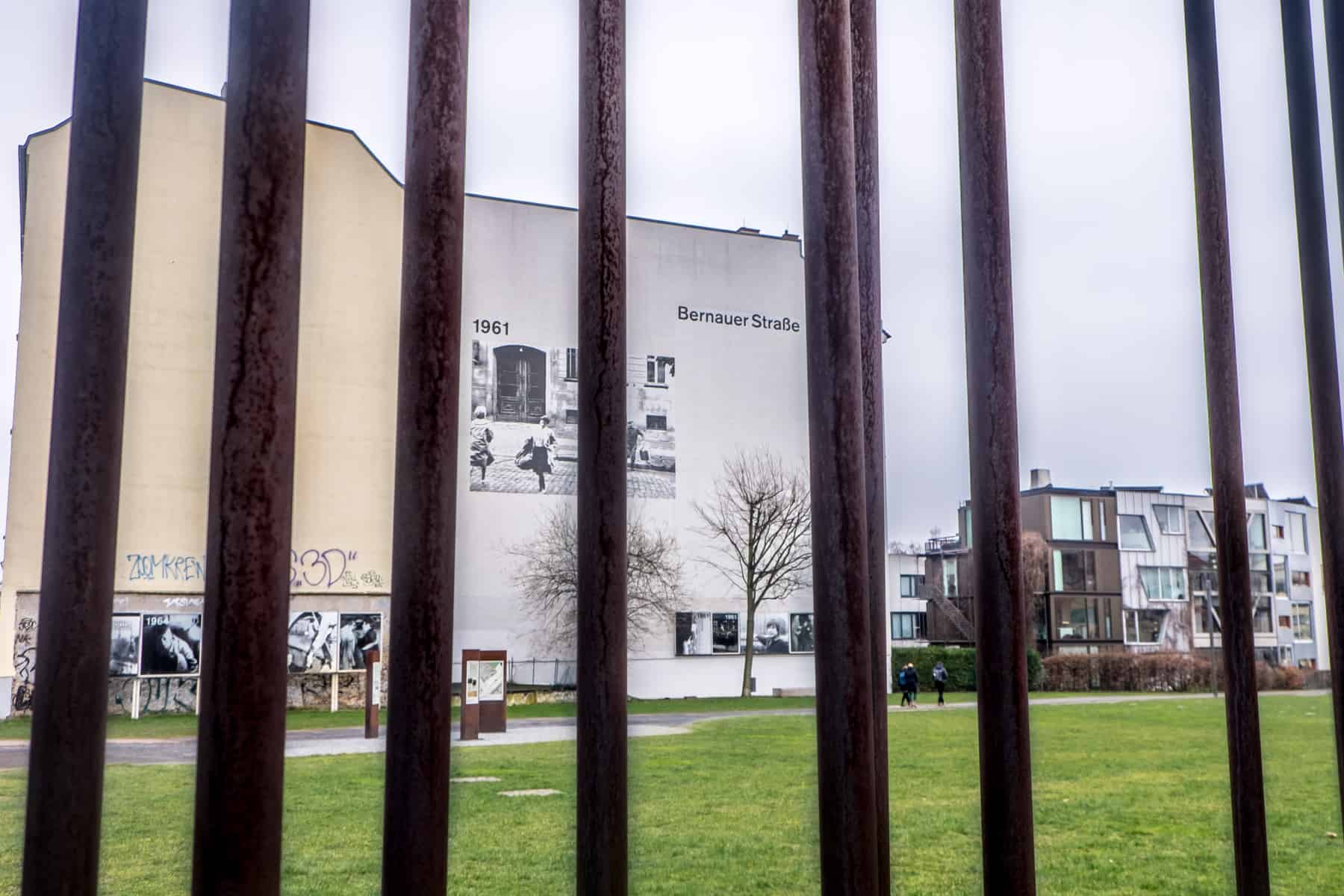
On the other side, you’ll notice the long brown bars where the Outer Wall and a watchtower once stood. The bars symbolise the imprisoned feeling of the Wall. There are also markings in the grass across the former border strip to highlight the route of the most famous and successful tunnels constructed for escape.
In the middle of the grassy strip, enclosed from the rest of the Memorial is a preserved area of the Border Strip, seen from the roof of the adjacent Berlin Wall Documentation Centre that is part of the Memorial grounds.

The Berlin Wall site at Bernauer Strasse is also where the first elements of unification took place. On 10th November 1989, the first sections of the Wall were knocked down to create a crossing between East and West Berlin. A year later in 1990, Bernauer Strasse also marked the place where the official demolition of the border fortifications began.
How to get to the Berlin Wall Memorial: U-Bahn Station Bernauer Strasse
The Berlin Wall Memorial Website has information on different tours and seminars at the Visitor Centre
The Topography of Terror – See the Berlin Wall Near Checkpoint Charlie
Located in the centre of the city, this section of the Berlin Wall is closest to Checkpoint Charlie – a mere 10-minute walk away. Its chiselled appearance is because this section of the Wall was chipped away for souvenirs, like those pieces of boxed rock that you can find in the stores. When I was in Berlin as a kid the ‘Wall Peckers’, as they came to be known, broke off pieces of the Berlin Wall and sold them as souvenirs on the street.
On the former site of the Gestapo and SS headquarters, The Topography of Terror is a permanent outdoor exhibition, combined with an indoor history museum.
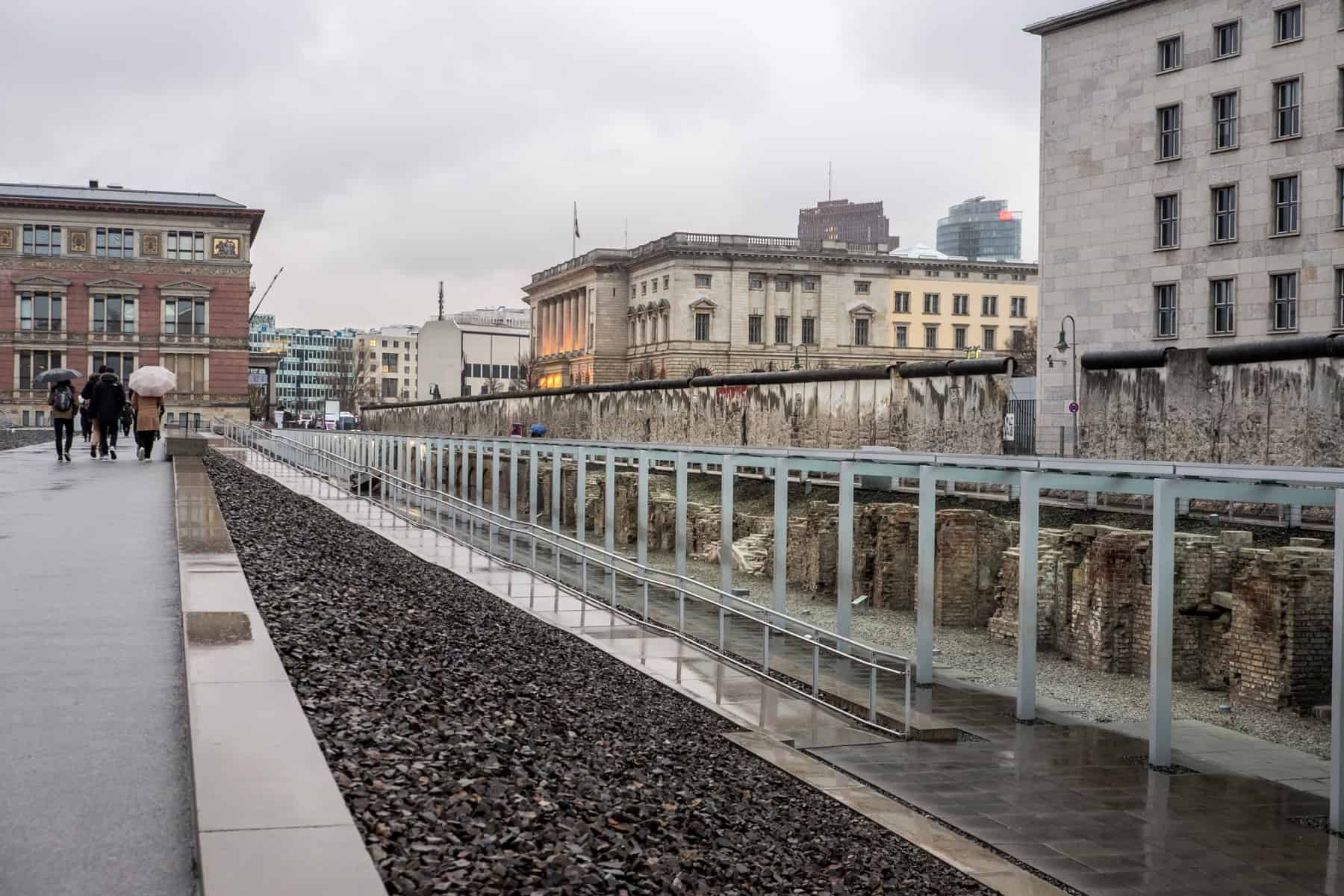
Outside, lining the front of the Berlin Wall and its foundations, are information boards presented as a timeline of events detailing the history from when the rise of the Nazi Party until the end of the war and the Berlin Wall construction.
How to get to the Topography of Terror: U-Bahn Station Kochstrasse
The Topography of Terror website provides information on guided tours and special exhibitions.
Günter Litfin Memorial – The Preserved Berlin Wall Watchtower
A preserved watchtower looming presides in front of a residential apartment block, as construction takes place around it to build up a former Border Strip area. As stark as the tower is, it remains as a memorial for all victims of the Berlin Wall killed by GDR border troops. It is also named for and in remembrance of Günter Litfin – the first person to be killed by East German forces and the second known person to die trying to cross the Berlin Wall.
A cross-border worker from the East and working in the West, Günter Litfin tried to get back to the West via the River Spree and caught when crossing the Railway Bridge that marked the border. At the time, his death was framed as an accident as the GDR government didn’t want to admit people were trying to escape openly.
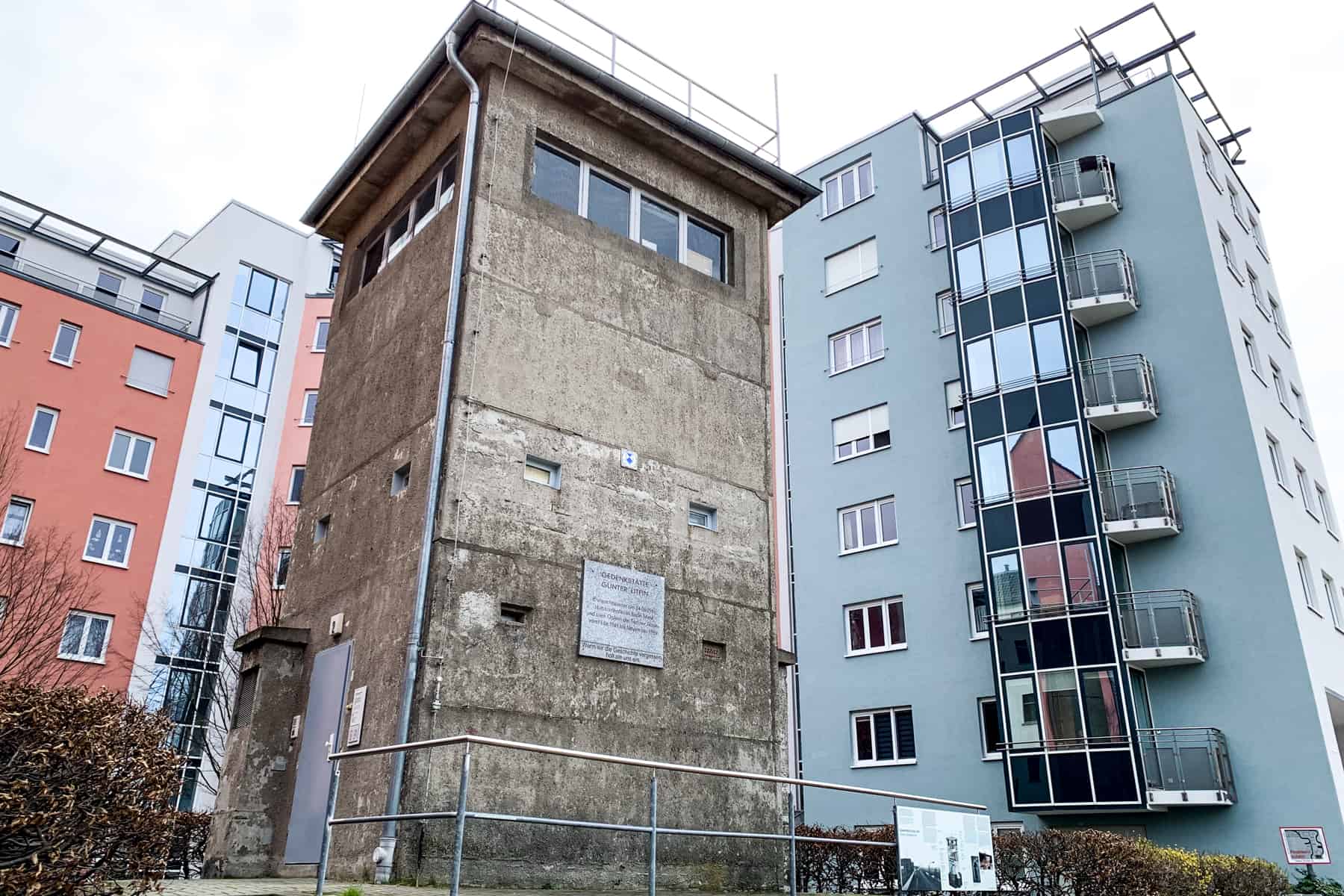
How to get to the Günter Litfin Memorial: U-Bahn Station Schwartzkopffstraße
You can read more about the story of Günter Litfin and how the Memorial can be here.
The Importance of Visiting Berlin Wall Sites
Berlin has changed dramatically since the fall of the Wall and German Reunification. Architectural remains of the former East remain, historic buildings restored and grand new buildings rising, yet the two halves of the city are now as one. A city once divided but which now thrives in unison.
Importantly, the dark history of the city is always at the fore, with plenty of museums, memorials and tours from which we can all learn from when visiting.
What are your thoughts about the Berlin Wall? Which parts have you seen, and how did it make you feel?
The post The Best Place to See the Berlin Wall and What to Learn From It appeared first on Borders Of Adventure.
from Borders Of Adventure https://www.bordersofadventure.com/best-place-to-see-the-berlin-wall/
VietNam Travel & Food Magazine Vina.com offers News✅ Travel info✅ Food Recipes✅ Photos✅Restaurant Guide at Vina.com https://vina.com/travel/nightlife/ https://vnfoodandtravelblog.blogspot.com/



0 Nhận xét